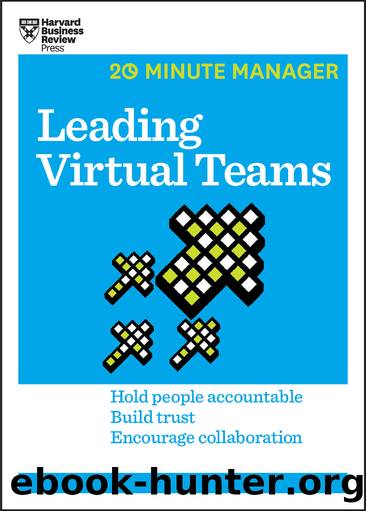Leading Virtual Teams (HBR 20-Minute Manager Series) by Harvard Business Review

Author:Harvard Business Review
Language: eng
Format: epub
Publisher: Harvard Business Review Press
Published: 2016-05-17T00:00:00+00:00
Keep people engaged
Your virtual water-cooler chats created beautiful and trusting relationships across the team. But how can you mobilize those social bonds to keep people engaged in, and motivated about, the work at hand?
Foster shared leadership. Assign special projects that team members can share during a meeting, or invite them to run a virtual team-building exercise, such as the weekly highlight-lowlight routine described earlier. As part of your plan to get the right people on the team, ask members to coach one another in their areas of expertise (refer back to your completed team surveys).
Recognize and praise collaborative behavior when you see it. If several people worked together to solve a problem, send an e-mail to the entire team expressing your appreciation and explaining how the work has helped the team overall.
Encourage people to acknowledge each otherâs work. Praise people for calling out each otherâs successes. Let them know that recognizing collaboration in others makes them look good, too. Develop norms for how members communicate that they âseeâ each otherâs work, and give feedback wherever possible. Even a bland âThanks,â âNice,â or âIâm using this right nowâ goes a long way. Sharing genuine praise and appreciation is a prerequisite to offering comments that might be more critical: Research suggests the right balance is 10 to 1. Foster candor by supplying team members with the language for criticism, such as âI might suggest . . . â or âThink about this.â
Play games. Games provide a low-stakes, fun environment in which team members practice pooling knowledge and coordinating for a common goal. This approach also helps members learn how other members think and act in an accelerated time frame and helps people iterate strategies for working together. For long-standing teams with a gamer culture, consider online role-playing games (RPGs) such as World of Warcraft, where team members talk as they play. If RPGs donât fit your team culture, look at mobile multi player games such as online Scrabble. Even sharing music or book recommendations gives people a chance to explore each otherâs thinking and connect on a personal level. Team-building activities can feel cheesyâitâs the nature of the beastâso encourage people to have a sense of humor about them: âItâs East Coast versus West Coast in Scrabble this week!â
Build a team with rhythm. Work in a physical office has a natural tempo: You see colleagues in predictable places at predictable times, you do certain kinds of work at the same time every day, you attend meetings with familiar people in familiar rooms. When some or all the members of a team are working remotely, itâs all too easy to feel disconnected without these patterns. One antidote is to be disciplined in creating and enforcing routines in virtual team work. Hold regular meetings, ideally on the same day and at the same time each week, starting and finishing on time. Make the meeting agendas routine where possible, and share them ahead of time. Good meeting practice matters more when you have a dispersed team, because following the rules helps create those shared expectations and experiences.
Download
This site does not store any files on its server. We only index and link to content provided by other sites. Please contact the content providers to delete copyright contents if any and email us, we'll remove relevant links or contents immediately.
Zero to IPO: Over $1 Trillion of Actionable Advice from the World's Most Successful Entrepreneurs by Frederic Kerrest(4241)
Machine Learning at Scale with H2O by Gregory Keys | David Whiting(4123)
Never by Ken Follett(3767)
Harry Potter and the Goblet Of Fire by J.K. Rowling(3759)
Ogilvy on Advertising by David Ogilvy(3485)
Shadow of Night by Deborah Harkness(3279)
The Man Who Died Twice by Richard Osman(2982)
Book of Life by Deborah Harkness(2855)
Will by Will Smith(2773)
0041152001443424520 .pdf by Unknown(2772)
My Brilliant Friend by Elena Ferrante(2761)
The Tipping Point by Malcolm Gladwell(2736)
How Proust Can Change Your Life by Alain De Botton(2727)
Purple Hibiscus by Chimamanda Ngozi Adichie(2628)
How to Pay Zero Taxes, 2018 by Jeff A. Schnepper(2578)
Hooked: A Dark, Contemporary Romance (Never After Series) by Emily McIntire(2484)
Rationality by Steven Pinker(2276)
Borders by unknow(2215)
Can't Hurt Me: Master Your Mind and Defy the Odds - Clean Edition by David Goggins(2167)
